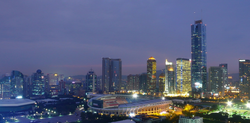This article needs additional citations for verification .(January 2010) |
Huadu 花都区 Huaxian | |
|---|---|
 Hongshan in Huadu District | |
 | |
 Huadu District in Guangzhou | |
| Coordinates: 23°22′37.99″N113°11′46.00″E / 23.3772194°N 113.1961111°E | |
| Country | People's Republic of China |
| Province | Guangdong |
| Sub-provincial city | Guangzhou |
| Area | |
• Total | 961 km2 (371 sq mi) |
| Population (2020 [1] ) | |
• Total | 1,642,360 |
| • Density | 1,710/km2 (4,430/sq mi) |
| Time zone | UTC+8 (China Standard) |
| Postal code | 510800 |
| Area code | 020 |
| Website | archived link |
| Huadu, Guangzhou | |||||||||||||||||
|---|---|---|---|---|---|---|---|---|---|---|---|---|---|---|---|---|---|
| Simplified Chinese | 花都区 | ||||||||||||||||
| Traditional Chinese | 花都區 | ||||||||||||||||
| Jyutping | faa1 dou1 keoi1 | ||||||||||||||||
| Hanyu Pinyin | Huādū Qū | ||||||||||||||||
| |||||||||||||||||
| Alternative Chinese name | |||||||||||||||||
| Chinese | 花都 | ||||||||||||||||
| Jyutping | faa1 dou1 | ||||||||||||||||
| Hanyu Pinyin | Huādū | ||||||||||||||||
| Literal meaning | flower capital | ||||||||||||||||
| |||||||||||||||||
| Second alternative Chinese name | |||||||||||||||||
| Simplified Chinese | 花县 | ||||||||||||||||
| Traditional Chinese | 花縣 | ||||||||||||||||
| Jyutping | faa1 jyun2 | ||||||||||||||||
| Hanyu Pinyin | Huāxiàn | ||||||||||||||||
| |||||||||||||||||
Huadu District is one of 11 urban districts of the prefecture-level city of Guangzhou,the capital of Guangdong,China. It is located in the far northern suburbs of the city.
Contents
- History
- Resources
- Administrative divisions
- Climate
- Transportation
- Metro
- People
- Sister cities
- References
- External links
Xinhua Town is the seat of local government,and of the district CCP committee. [2]
While the Cantonese dialect is universally spoken,about 1/3 of the population consists of Hakka dialect speaking peoples. [3] The district is the ancestral home of many Overseas Chinese.
Formerly known as Hua County,it was the hometown of many Taiping Rebellion leaders like Hong Xiuquan and Hong Rengan.



